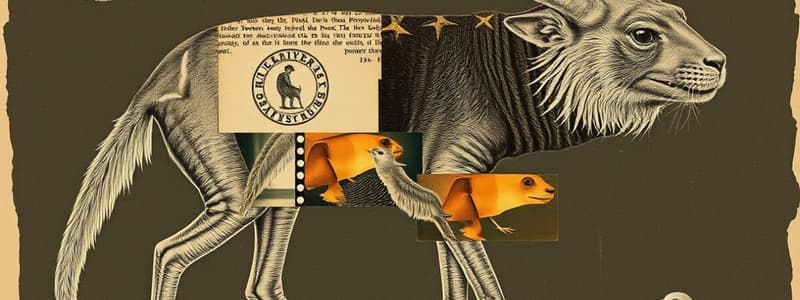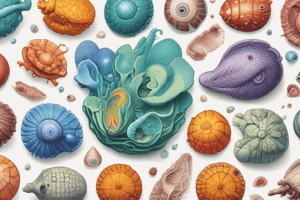Podcast
Questions and Answers
What is the primary challenge that terrestrial animals face related to temperature?
What is the primary challenge that terrestrial animals face related to temperature?
- Excessive heat production
- Weak structure of chemical bonds (correct)
- Limited food sources
- High levels of oxygen availability
What defines endotherms in terms of body temperature regulation?
What defines endotherms in terms of body temperature regulation?
- They maintain body temperature within a narrow range. (correct)
- They primarily depend on external heat sources.
- They conform their body temperature to the environment.
- They primarily inhabit aquatic environments.
What characteristic feature distinguishes the majority of animal phyla?
What characteristic feature distinguishes the majority of animal phyla?
- Greater diversity in terrestrial environments
- Ability to produce their own food
- Presence of rigid cell walls
- Predominance of invertebrates (correct)
What enables animals to have the ability to move actively?
What enables animals to have the ability to move actively?
What is the significance of the zygote in embryonic development?
What is the significance of the zygote in embryonic development?
Which of the following statements about sexual reproduction in animals is accurate?
Which of the following statements about sexual reproduction in animals is accurate?
How does the body plan of animals typically develop during early embryonic stages?
How does the body plan of animals typically develop during early embryonic stages?
In which category do warm-blooded animals, such as birds and mammals, fall?
In which category do warm-blooded animals, such as birds and mammals, fall?
What is the primary advantage of bilateria's body mobility?
What is the primary advantage of bilateria's body mobility?
What evolutionary trend does cephalization refer to?
What evolutionary trend does cephalization refer to?
Which body cavity type is characterized by the absence of a body cavity?
Which body cavity type is characterized by the absence of a body cavity?
How do body cavities contribute to the digestive process in bilateria?
How do body cavities contribute to the digestive process in bilateria?
What feature is associated with pseudocoelomate organisms?
What feature is associated with pseudocoelomate organisms?
What is one function of body cavities in bilateria related to reproductive strategies?
What is one function of body cavities in bilateria related to reproductive strategies?
What is primarily observed in bilateria compared to radiata regarding sensory structures?
What is primarily observed in bilateria compared to radiata regarding sensory structures?
What was a significant evolutionary advancement in bilateria during early evolution?
What was a significant evolutionary advancement in bilateria during early evolution?
What is the function of the parietal peritoneum in coelomates?
What is the function of the parietal peritoneum in coelomates?
Which of the following is characteristic of the closed circulatory system?
Which of the following is characteristic of the closed circulatory system?
Which structure does the blastopore develop into in protostomes?
Which structure does the blastopore develop into in protostomes?
What differentiates protostomes from deuterostomes regarding embryonic development?
What differentiates protostomes from deuterostomes regarding embryonic development?
During which process does the coelom form in protostomes?
During which process does the coelom form in protostomes?
How does the gut in coelomates contribute to the development of a circulatory system?
How does the gut in coelomates contribute to the development of a circulatory system?
In deuterostomes, how does the coelom develop?
In deuterostomes, how does the coelom develop?
Which of the following statements is NOT true regarding coelomates?
Which of the following statements is NOT true regarding coelomates?
What does the mesoderm ultimately develop into?
What does the mesoderm ultimately develop into?
Which cleavage pattern characterizes protostomes?
Which cleavage pattern characterizes protostomes?
What is metamerism in early development?
What is metamerism in early development?
What is a significant advantage of early embryonic segmentation?
What is a significant advantage of early embryonic segmentation?
Which of the following organisms is not known for true segmentation?
Which of the following organisms is not known for true segmentation?
What does radial cleavage allow in deuterostomes?
What does radial cleavage allow in deuterostomes?
What is the primary characteristic distinguishing parazoans from eumetazoans?
What is the primary characteristic distinguishing parazoans from eumetazoans?
Which subkingdom includes animals with symmetry and organized tissues?
Which subkingdom includes animals with symmetry and organized tissues?
How many tissue layers do diploblastic organisms have?
How many tissue layers do diploblastic organisms have?
What is one of the most prominent features of the body plans of true animals?
What is one of the most prominent features of the body plans of true animals?
What is the first key transition in animal body plans according to the provided content?
What is the first key transition in animal body plans according to the provided content?
Which of the following characteristics is NOT generally associated with eumetazoans?
Which of the following characteristics is NOT generally associated with eumetazoans?
Flashcards are hidden until you start studying
Study Notes
Animal Diversity Overview
- Diversity refers to the variety and forms of animals, ranging from the smallest to the largest species.
- Terrestrial animals struggle with temperature variations due to weak chemical bonds regulating proteins and enzymes, which are affected by temperature changes.
- Adaptations to temperature vary:
- Endotherms (birds and mammals) maintain a constant internal temperature.
- Ectotherms adjust their body temperature according to the environment for energy efficiency.
General Features of Animals
- Animals are unicellular or multicellular heterotrophs, dependent on plants for food.
- About 98% of animals are invertebrates, existing in diverse forms and sizes, from microscopic to gigantic.
- Animal phyla distribution: predominantly found in the sea, followed by freshwater, then land.
- Major phyla dominating terrestrial life: Arthropoda, Mollusca, and Chordata.
- Animals lack rigid cell walls, allowing cells to form flexible tissues for specific functions (e.g., nerve tissues).
Movement and Reproduction
- Active movement is a distinctive feature, facilitated by the evolution of nervous and muscular tissues.
- Most animals reproduce sexually, with immobile eggs larger than flagellated sperm and typically no alternation of generations.
Embryonic Development
- Similar embryonic development patterns across most animals:
- Zygote undergoes mitosis to form a morula, a solid ball of cells, leading to the blastula (hollow cell ball).
- Gastrula stage may involve the formation of the blastophore, which develops into the digestive system.
Subkingdom Classification
- Two main subkingdoms:
- Parazoa: Symmetry, tissues, and organs are absent (e.g., sponges).
- Eumetazoa: Exhibits symmetry, definitive shapes, and organized tissues into organ systems.
Body Plan Features
- Animal classification hinges on morphological and developmental characteristics, culminating in bilateral symmetry.
- Key distinguishing traits include tissue layer count during development, presence/absence of body cavities, and embryological features.
Key Transitions in Body Plan Evolution
- Evolution of tissues marks the initial key transition; simplest animals (parazoans) lack defined tissues and organs.
- Bilateria display enhanced mobility, aiding in food acquisition and predator avoidance, with sense organs concentrated at the anterior region.
- Cephalization: Evolutionary trend towards the development of a head and brain area.
Body Cavity Evolution
- Emergence of body cavities marks a crucial evolution in complexity, allowing efficient organ systems.
- Cavities support organs, distribute materials, and facilitate intricate interactions, enhancing digestion and reproduction.
Types of Body Cavities in Bilateria
- Acoelomate: No body cavity.
- Pseudocoelomate: Body cavity between mesoderm and endoderm.
- Coelomate: Coelom within the mesoderm, providing proper organ support and circulation.
Circulatory Systems
- Open circulatory system: Blood fills body cavities (hemocoel) to bathe tissues.
- Closed circulatory system: Blood separated from other fluids for controlled circulation, improving efficiency.
Protostomes vs. Deuterostomes
- Coelomates differ in embryonic development:
- Protostomes: Mouth develops from blastopore.
- Deuterostomes: Anus develops from blastopore.
- Coelom formation:
- Protostomes undergo schizocoely (splitting mesoderm).
- Deuterostomes utilize enterocoely (pouches formed from endoderm).
Cleavage Types
- Protostomes exhibit spiral cleavage; cells are misaligned.
- Deuterostomes undergo radial cleavage; cells align parallel or perpendicular to the polar axis.
Evolution of Segmentation
- Segmentation (metamerism): Body divided into segments, influenced by mesoderm initially, and later reflected in ectoderm/endoderm.
- True segmentation is evident in annelids, arthropods, and chordates.
- Benefits of segmentation:
- Each segment can develop its organ systems and replicate functions if damaged.
- Enhanced locomotion through independent segment movement.
Studying That Suits You
Use AI to generate personalized quizzes and flashcards to suit your learning preferences.




